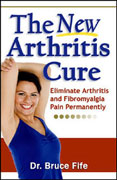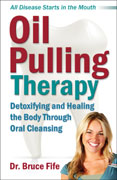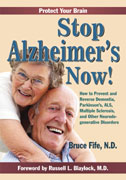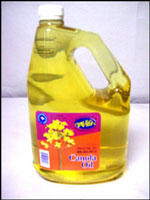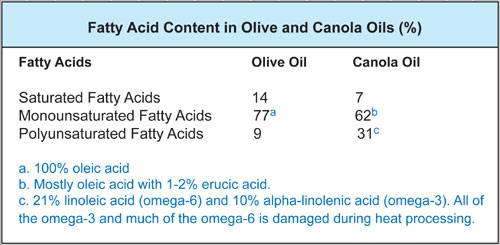|
E-Mail Edition Volume 9 Number 2 |
|||
|
Published Spring, 2012 Published by Piccadilly Books, Ltd., www.piccadillybooks.com. Bruce Fife, N.D., Publisher, www.coconutresearchcenter.org |
|||
|
If you would like to subscribe to the Healthy Ways Newsletter
|
Contents
|
||
|
by Dr. Bruce Fife
Available from Piccadilly Books, Ltd.
by Dr. Bruce Fife
Available from Piccadilly Books, Ltd.
|
Ask Dr. Coconut
I have arthritis in my finger and thumb joints and one foot, also knees and lower back. I have a lot of pain and inflammation. I have been taking 200 mg of Celebrex to control the pain. Can coconut oil help?
Coconut oil combined with good oral hygiene, a healthy diet, certain dietary supplements, and exercise can work wonders for arthritis. I've written a book on this topic titled The New Arthritis Cure: Eliminate Arthritis and Fibromyalgia Pain Permanently. The book is based in part, on the work of Dr. Weston A. Price, DDS. Price was a dentist and served as the research director for the American Dental Association back in the early 1900s. He is most famous for his groundbreaking book Nutrition and Physical Degeneration, originally published in 1939. In the early 1920s he published a two volume set of books on dental health which explained how the health of a person's teeth can affect the health of their entire body. He gave numerous examples of how various health problems could be corrected by addressing dental issues. One of the most common health problems he encountered was arthritis. After addressing the patients' dental issues their arthritis would quickly go away. He believed that most forms of arthritis, including rheumatoid and osteoarthritis, were due primarily to infection that originated from the mouth. His books go into great detail documenting the science behind this. The first step of the arthritis program outlined in my book is to address any existing dental issues and improve oral hygiene. The book explains how to do this using a technique called oil pulling, which uses coconut oil. This process "pulls" bacteria and deep rooted infections out of the mouth. This eliminates the source of the bacteria that continually seeps into the bloodstream and finds its way into joint tissue. The second step is to take coconut oil as a systemic antibiotic. Pharmaceutical antibiotics are ineffective against arthritis because they cannot easily penetrate into the joint tissue. Anti-bacterial medium chain fatty acids from coconut oil however can, thus eliminating the infection in the joints. These two steps combined with a proper diet and dietary supplementation enhances the effects and prevents reoccurrence of the infections. After reading three of my books one 86-year-old woman wrote, "I started using coconut oil about 3 months ago. I have arthritis in my right knee and my left hip to the extent I could not walk without pain. This has gone on for years. My daughter found out about coconut oil through her home school organization. I started using it and now I can pick up my leg and walk without pain in my hip or leg. Plus, many more good things have happened." Fibromyalgia can also be treated using this same program. "I have had fibromyalgia for about five years and arthritis in my back for three," says Shannon Lundin. "I was progressively getting worse. The arthritis in my back was constant, never ending pain, and my fibro came and went, some days worse than others. I did not want to take medication. I don't want to mask one problem and cause a series of other problems. So, I lived with the pain, slowly gaining weight and feeling miserable. "In July my wonderful husband said enough is enough and started researching online. He came across your book, The New Arthritis Cure, and asked me to order it. We read it and he said he wanted me to do the whole foods diet [described in the book] and coconut oil. I told him I don't think I have the willpower to change the way I eat and watch my family continue to eat the foods I love. So, he said he would do it with me. We started the middle of August. I am happy to report (after 3½ months) that I am completely pain free! I feel so good! I am happier. I have lost 19 pounds to date and still losing. I am exercising. It is wonderful. "About a month ago I found out that I have borderline osteoporosis. Again, I don't want to take the medication, I am too young (42 years old). So, I am fighting it with weight exercises. Several months ago I would not have been able to exercise the way I need to. I am so grateful to you and my husband. My children are tired of hearing about how great I feel and me telling people what I am doing to feel so great. They ask if I get tired of telling people and I don't. I am so excited and I want the world to know that it can be done. It is not easy at first, but once you get over the first hurdle it is so easy. I do not crave the sugars and junk anymore. Another bonus is my husband also feels great. He also is able to exercise more than he did before. We are true believers." By itself coconut oil can do a lot to improve a person's health. However, when it is incorporated into a treatment program designed to address specific health issues it can work miracles. ■
|
||
|
|
|||
|
Autism Reversed with Virgin Coconut Oil By Rosemarie P. Rosales
Autism is a developmental disability that affects how the brain functions, especially in those areas of the brain that control social ability and communication skills. Boys are most likely to develop autism, and most children are diagnosed before the age of three. My name is Rosemarie Rosales. I live in Lapu-Lapu City, Cebu, Philippines. My son Homer Ponce Rosales was diagnosed March 13, 2002 with autism spectrum disorder (ASD). He was one week away from his fourth birthday. My primary concern at that time was his speech delay. Imagine, he was almost fours years old but I had yet to hear him call me Mama (the sweetest word a mother hears from her child). His hyperactivity bothered me greatly. He was so hyperactive that as soon as he stepped out of the house he wouldn't come back because he didn't know how to get home. He goes into our neighbors' homes without their permission and destroys their belongings—computers, vases, TV, stereo, etc. He would enter people's homes unnoticed. The owners would open a door and be shocked to find him all alone in their homes. He had no fear of danger. He never indicated if or when he was hungry. He never played with other kids and usually harmed them by throwing stones at them or striking them with hard objects. He was so destructive in church, restaurants, and stores that we rarely took him to public places. Oh my, what kind of a child I have! |
|||
|
Despite behavioral therapy, Homer showed little progress. Then God guided me to PRIME Center Foundation. Mr. Roni Romeo Ocubillo, the founder of this special school introduced me to a gluten-free and casein-free diet. His approach was supported by studies that demonstrated that certain foods seem to affect the developing brains of some children with autism. This is not because of allergens but because many of these children are unable to properly break down certain proteins. Researchers in England, Norway, and the USA have found peptides (breakdown products of proteins) with opiate activity in the urine of a large percentage of autistic children. Opiates have drug-like effects that alter brain function. The two main offenders seem to be gluten (a protein found in wheat, oats, rye, and barley) and casein (milk protein). Some researchers believe that in certain children, these foods have a drug-like effect on their brains causing autistic behavior. He told me that autism seems to be an immune system dysfunction. Leaky gut syndrome also appears to be involved. The leaky gut permits undigested proteins from gluten and casein to pass through the intestinal wall and into the bloodstream. The bloodstream then transports them into the brain where they disrupt normal brain function. Candida and other yeasts live in our bodies in small amounts. It is believed that in individuals with improperly functioning immune systems, candida could flourish, damaging the intestinal wall leading to leaky gut syndrome. Some of the symptoms of candida overgrowth in children include sugar cravings, headaches, hyperactivity, and behavior and learning problems. So candida also may, in part, be responsible for autistic behavior. Many parents of children with ADD or ADHD, as well as those with autism, report that treatment for candida does in fact improve their children's behavior and concentration. Nystatin, an antifungal drug used to fight candida, is recommended to all the autistic children enrolled in the PRIME program. At the age of four, Homer began his special school and his new diet. We eliminated all foods containing gluten and casein. Many of my son's favorite foods such as spaghetti, oatmeal, and milk were now off limits. Nystatin was given to him to control candida and aid in building a healthy digestive tract. The program seemed be working. His hyperactivity lessened, he could focus more, and could talk a little with some sense. When I ask, "What are you doing Homer?" He could answer "Safeguard, wash." After following the gluten-free and casein-free diet for almost 10 months, I felt my son was on his way to lasting improvement. His behavior improved, he became more manageable, he began to socialize with other kids, could read and write a little, and talk a little. I was really very happy and satisfied with his progress. To our dismay, we got another blow when Homer came down with pneumonia. He was confined at the hospital and advised to rest. He was absent from his therapy for a full month. During his stay at the hospital the nurses and doctors had a hard time putting in his IV. He was very strong. It literally took hours to attach the IV. When he felt the pain, instead of calling "Mama," he shouted: "Help Barney! Mickey Mouse help! Superman, Batman!" My goodness...what a child I have! He wouldn't take his medicines orally because he didn't like the taste. It was a struggle for me at the hospital taking care of him. He got his medicines, mostly antibiotics, through his IV. He didn't like to eat. He was asking for his spaghetti, wanted to drink milk and other foods prohibited on his therapy diet. He wasn't eating properly. I was worried about his ability to fight off the infection. I called PRIME and asked permission to allow Homer to eat the foods he liked for the sake of his health. When he went back to his school, all of the staff, including Mr. Ocubillo the foundation's director, were disappointed and frustrated with his behavior. He was back to zero. His autism was so prevalent again! He was very hyperactive again. We had to start all over. Mr. Ocubillo told me that it was due to the antibiotics while he was hospitalized. The antibiotics not only killed the bacteria that caused his pneumonia but also the good intestinal bacteria, which help keep candida under control. I was so depressed with this regression, I don't remember how many times I cried. But still, I didn't lose hope. I prayed hard to God for His guidance. I have a strong faith that God has His purpose for giving me this special child. My prayers were answered and the answer came from an unlikely source—virgin coconut oil. I had heard how coconut oil could be used to strengthen the immune system, prevent illness, and improve health. I began to take it daily by the spoonful as a dietary supplement. I observed that my overall health improved, including my asthma. I thought it might help Homer by building up his immune system. He didn't want to take the oil and it took awhile to get him to take his first spoonful. I continued to give it to him every day and sometimes three times a day. After two months, I noticed a dramatic improvement in his behavior and especially in his speech. Up until then, he had only been able to understand and speak a little in English. Now, not only was his English improving, but for the first time he was beginning to speak in Cebuano—our native dialect. Autistic children often never learn to speak and when they do, they have limited communication skills. Homer was learning to speak two languages! Homer is now 7 years old. Autistic characteristics such as echolalia (a seemingly unconscious habit of repeating words or phrases spoken by others) and ritualistic behavior are gone. He can read very well and write clearly. He can tell stories and express his feelings and ideas and has plenty of friends. He asks permission when going to our neighbors' houses and knows his way back home. I shared my knowledge of coconut oil with Mr. Ocubillo at PRIME. At first, he was skeptical. So I gave him some articles to read. He was also given a copy of Dr. Bruce Fife's book The Coconut Oil Miracle. In the book Dr. Fife describes, among other things, the antifungal properties of coconut oil. That's when I realized that coconut oil killed the candida in my son's intestines. Originally, my only purpose in giving Homer the oil was to improve his immune system. I never realized that his autism would be gone with the help of coconut oil. What an amazing miracle! Mr. Ocubillo researched coconut oil further and now all the children at the PRIME Center Foundation are taking virgin coconut oil daily. It has replaced the antifungal drug Nystatin formerly used. This coming June, Homer will be attending regular classes at a private school. During the evaluation process the principal was impressed because Homer can read very well. He got a score of 61 out of 65 on the written exam. Thanks to coconut oil I can say "goodbye" to PRIME Center forever and say "welcome to the world of regular students!"
|
|||
|
Homer, wearing red stripped pants, participating in church activity.
Update one and a half years later: Homer is very talkative with a good vocabulary. He can speak what is on his mind. He has plenty of friends in school, neighborhood, and in our church. Homer is doing great in his regular school. He's one of the top five students in the class. He has even joined the church choir.
|
|||
 Homer, far right, singing in church youth choir.
|
|||
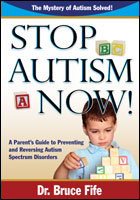
by Dr. Bruce Fife
Available from Piccadilly Books, Ltd.
|
His behavior has changed remarkably. We now enjoy going to malls, parks, and restaurants. I no longer have to constantly keep a hold of him. When my hands are full when we go to the market, either he just trails me from behind or holds on to my clothes. He is now a typical child, very different from what he was three years ago. Sometimes, he surprises me. He hugs and kisses me for no apparent reason. The initiative comes from him. Affection is something I missed when he was younger. I read the [above] story about Homer to my husband Jun. Homer was in the room playing with a game. When I read the words "Homer is autistic," he spontaneously said, "I'm not autistic anymore!" He's right, he not. Some parents especially those who first encounter Homer cannot believe that he was once a "special" child. Homer is not on a special diet any more. He eats anything he wants, including his fair share of sweets and junk foods. However, he continues to take his coconut oil every day. Lastly, I would like to extend my warmest gratitude to Dr. Bruce Fife for sharing with us this wonderful knowledge about the healing miracles of virgin coconut oil. God bless you and more power!
Dr. Fife's Comments Over the years a number of parents have reported that coconut oil has helped their special needs children overcome developmental disorders such as autism, ADHD, and epilepsy. Rosemarie Rosales attributed the improvement she saw in Homer to coconut oil's ability to rebalance the microbial environment in Homer's digestive tract and heal damaged tissue. Studies have shown that autistic children have a high population of bad microflora such as candida, E. coli, and Clostridium tetani (tetanus), and lower populations of good microflora than normal children. These bad microorganisms cause chronic inflammation and damage the intestinal wall, interfering with digestion and nutrient absorption. Coconut oil helps reestablish a healthy gastrointestinal environment by killing the bad bacteria, encouraging the growth of good bacteria, and stimulating the healing of the damaged intestinal lining. Coconut oil, however, does far more than just heal the digestive tract, it can help rebalance the brain as well. The key is found in coconut ketones. Ketones are energy producing molecules made from fats. Our bodies can make them from stored fat or from special fats known as medium chain triglycerides (MCTs) found in coconut oil. Ketones are produced specifically by the body to feed the brain. Richard Veech, MD, a long time ketone researcher and senior scientist with the US National Institutes of Health describes ketones as "superfuel for the brain." Ordinarily glucose powers our brain's cells. However, when the brain is plagued with chronic inflammation, irritation, and immune over activation, as is seen in all autistic children, brain cells have difficulty processing glucose. The lack of sufficient fuel causes the brain to downshift into a lower rate of performance. Normal growth and development are stifled and learned skills may become lost as the brain's cells are starved for energy and struggle for survival. Ketones act as an alternative fuel to glucose—a much more potent and efficient fuel. When ketones are available, it is like putting high performance gasoline into the tank of your car. You get better gas mileage, higher performance, with less wear and tear on the engine and less pollution. Ketones bypass the defect in glucose metabolism and provide the brain with the energy it needs to function and develop properly. Ketones not only supply a superior source of energy to the brain but trigger the activation of specialized proteins called brain derived neurotrophic factors that function in brain cell maintenance, repair, and protection. They also stimulate the growth of new brain cells to take the place of dead or dying cells. This allows healing and repair to take place. Ketones are ordinarily produced when blood glucose levels become low. Since glucose is the body's primary source of energy, when glucose levels fall, the body starts mobilizing stored fat to produce ketones to maintain adequate energy levels. Medical science has learned how to alter blood ketone levels by manipulating the diet. Ketogenic diets, which boost ketones to therapeutic levels, have been used successfully for decades for the treatment of other neurological disorders, most notably epilepsy. More recently they are being used to treat Alzheimer's and Parkinson's disease. Another way to elevate blood ketone levels to therapeutic levels is to consume a source of MCTs. There are very few dietary sources of MCTs. The richest dietary source by far comes from coconut oil. Coconut oil is composed predominately of MCTs. Eating coconut oil can raise blood ketones to levels that can have a pronounce effect on brain growth and development. Feeding your child coconut oil or MCTs is not as strange as it might seem. MCTs are a normal and natural source of nutrition for infants and small children. Another source of MCTs is found in human breast milk. This isn't some accident of nature, they are there for an important reason. They are essential for proper brain development. In fact, MCT-derived ketones provide the basic building blocks for new brain tissue. They are required to build baby's brains as well as provide needed energy. In fact, coconut oil or MCTs are added to all commercial and hospital infant formulas to assure proper brain growth and function. Autism has long been considered an enigma to medical science. Most doctors have no clue what causes it or any idea how to prevent or treat it. The only medically recognized form of treatment is an attempt to teach affected children how to manage the disorder and live with it. Antidepressants, antipsychotics, and stimulants are often prescribed to help cope with symptoms. No possibility of a cure is offered, as the condition is considered permanent—in other words "hopeless." Autism, however, is not a hopeless condition. It can be prevented and successfully treated without the use of drugs. The combination of coconut oil with a low-carb diet is proving to be very successful in stopping autism. The details of this new dietary approach are contained in my new book Stop Autism Now! A Parent's Guide to Preventing and Reversing Autism Spectrum Disorders. Finally, there is a hope for those with autism. ■
|
||
|
|
|||
|
by Dr. Bruce Fife
Available from Piccadilly Books, Ltd.
|
Coconut Oil Improves Brain Health in Alzheimer's Patients
More Testimonies on the Therapeutic Benefits of Virgin Coconut Oil in Treating Dementia
Wife Showing Remarkable Improvement Virgin coconut oil (VCO) which is rich in medium chain fatty acids is known to inactivate a number of pathogenic organisms. Its antibacterial, antiviral, and antiprotozoal activities are well documented. Dr. D. S. Rawat, a retired scientist at the Indian Council of Agricultural Research has been treating his wife for Alzheimer's disease with virgin coconut oil supplied by Central Plantation Crops Research Institute for the past 8 months. She has been having 1 tablespoon of VCO orally twice a day (although Dr. Fife and Dr. Newport recommend 5+ tablespoons daily for best results). Dr. Rawat reports that his wife has shown remarkable improvement on taking VCO for the treatment of her Alzheimer's disease during the last eight months. A slight gain in body weight is noticed, her posture is improved, and her skin has regained its normal glow. She is better composed, calmer, and responding to what is being told to her. Her fast fading vocabulary has reversed; she is speaking words that she had forgotten for months. She responds when addressed by name and recognizes family members and relatives but cannot yet call them by name. Her sleep patterns have also improved, though not regular yet. Her digestion has improved. Dr. Rawat is thrilled that VCO has helped his wife. He regrets that he did not come across the case study by Dr. Mary Newport earlier when his wife was in the first stages of Alzheimer's disease. Nevertheless, he is happy with the good results he is seeing from VCO now and has requested the institute to supply him more quantity VCO. The experience of Dr. Rawat adds another testimony to the therapeutic benefits of VCO. ■
Source: http://www.cpcri.gov.in/
Coconut Oil and Alzheimer's: Our Story
Ian Hamilton says, "Coconut oil gave me back my brain!"...I'm as sharp as I've ever been...It was almost like clicking back into place...If you're getting a bad memory—get on coconut oil!" see video at http://www.youtube.com/watch?v=mMw3d3ohx_s .
|
||
|
|
|||
|
|
Is Canola Oil Healthy?
Some people claim that canola is the healthiest of oils, even better than olive and coconut oils. Others say it is a genetically engineered monster that is 100 times more toxic than soy. Who is right?
Whenever I shop for food I always read ingredient labels. I won't buy anything until I know what's in it first. There are certain ingredients that I especially look for and avoid. One of these is canola oil. I won't touch it. If you go to the grocery store or even a health food store you will see all types of foods proudly proclaiming they are made with canola oil. You see it in every type of food imaginable from frozen dinners and cookies to salad dressings and mayonnaise. In order to avoid trans fats in hydrogenated oils, many restaurants are now using canola oil for high temperature deep frying. You can even buy it by the bottle for home use. Canola oil has gained a reputation as one of the "good" fats because it is primarily a monounsaturated fat, like olive oil, which is regarded as one of the healthiest of all the fats. Many people claim canola oil is even better than olive oil because, next to flaxseed oil, it contains one of the highest amounts of omega-3 fats. Omega-3s are believed to help prevent heart disease. Olive oil contains no omega-3 fats. Canola also has less saturated fat than olive oil and a higher percentage of polyunsaturated fat (see chart below). Because of these things, canola oil has received a great deal of recognition as the "premier" monounsaturated fat and is aggressively promoted as a health food by food producers. But how healthy is it really? Food produces have learned from years of experience that if they present a poor quality food as healthy, it will become a best seller. That is the situation with canola oil. The truth is, canola oil is not a healthy oil at all. In fact, it is one of the unhealthiest oils you could ever eat and you should avoid anything and everything that contains it. Let me explain why. Canola oil is not a natural oil. Corn oil comes from corn, coconut oil comes from coconut, soybean oil comes from soybeans, but where does canola oil come from? There is no such thing as a "canola" plant. Canola oil is a man-made product never before seen in nature or eaten by humans until a few years ago thanks to the wonders of modern chemistry and biological manipulations. There is no canola plant or a canola seed. Canola oil comes from hybridized, genetically modified rapeseed plants. In other words, it is a man-made variety of rapeseed. The name rape-seed is a fitting description to its unsavory character. The oil from natural rapeseed contains toxic substances known as glucosinolates and a particularly nasty fatty acid called erucic acid. Bugs won't eat the seeds from this plant. The glucosinolates are natural insecticides with a bitter disagreeable taste. It is known to cause metabolic disorders in animals and, therefore, is not fit for animal or human consumption. In fact, it is illegal to sell rapeseed oil for human consumption. Those who promote the use of canola oil would have you believe that it is simply a product of traditional plant breeding techniques, which is done all the time without much complaint because it is viewed as more or less a natural process. However, the hybridization involved with the creation of canola oil is far from being natural. It can only be accomplished in a laboratory using a genetic methodology called seed-splitting, which is far removed from the cross pollination methods of traditional plant hybridization. In seed-splitting scientists use gas chromatography to identify the genes they want to manipulate, and then they seed-split to germinate a half seed. Through a sequence of trial and error combining parts of different split seeds they developed plants with the characteristics they were looking for. The process of combining pieces of fractionated seeds from various sources in this manner has resulted in a product that is like a Frankenstein monster. It is this technology that eventually led to the development of genetic engineering. Much of the concern about using rapeseed oil as a food source is due to its erucic acid content. Erucic acid is a 22 carbon long chain monounsaturated fatty acid. Animal studies have shown that erucic acid causes fatty deposits in the heart and cardiac fibrosis.1-2 Cardiac fibrosis is an abnormal thickening of the heart valves and loss of flexibility, which can lead to valve dysfunction and heart failure. Erucic acid also lowers the ability of the heart to produce the energy it needs to function properly, again increasing risk of heart failure.3 These effects can be observed even when erucic acid is reduced to as little as 2 percent.4 Rapeseed grows very well in cool climates such as in northern Europe and Canada. Most commercial crops don't fare well in these climates. Realizing the economic potential, Canadian plant breeders set out to develop a more palatable and safer rapeseed plant to use as animal feed that can thrive in the cool Canadian climate. Their primary goal was to reduce the glucosinolates but in so doing they also removed a gene responsible for producing most of the erucic acid. Natural rapeseed oil contains as much as 50 percent erucic acid. This new rapeseed oil had less than 5 percent, which would allow it to be sold as human food and greatly increase its marketing potential. Originally, the new rapeseed oil was referred to as "LEAR" oil for "Low Erucic Acid Rapeseed." Fearful that consumers might question the sanity of eating "rapeseed oil" the developers coined the name "canola oil." The name is an acronym for "Canadian Oil Low-Acid" (Can. O. L. A.). In addition, the name "canola" rhymes with "granola" suggesting a natural or healthy product. Give a product a fancy new healthy sounding name and it is sure to sell well. It was immediately marketed as a heart-friendly monounsaturated oil with all the benefits of olive oil but even better because it has less saturated fat and up to 10 percent omega-3 fatty acids. Promoters praised canola oil as the ultimate healthy oil. "Food grade" rapeseed oil (canola oil) is not entirely erucic acid-free. It is illegal to sell rapeseed oil for human consumption if it contains more than 2 percent erucic acid by weight in the USA and more than 5 percent in Europe. Although most of the erucic acid has been removed, would you want to eat an oil that contains even a small amount of a toxin that attacks the heart? Studies have shown that even as little as 2 percent can have detrimental effects on the heart and circulatory system. This is one of the reasons why canola oil is not allowed as an ingredient in baby food. It is also not recommended for breastfeeding mothers because erucic acid is deposited in the mother's milk fat. If canola oil is not good for babies, why would it be any better for adults? A number of studies have evaluated the health effects of consuming canola oil. While it may help reduce total cholesterol and LDL (so-called bad) cholesterol like most other vegetable oils do, it also decreases HDL (good) cholesterol.5 HDL cholesterol is believed to protect against heart disease and, therefore, reducing it increases the risk of heart attack and stroke. So, despite the spin promoters put on it, canola provides absolutely no benefit for the cardiovascular system. When fed to lab animals canola oil causes an increase in blood pressure, promotes insulin resistance, increases risk of stroke, causes kidney lesions, and shortens life span.6-10 While all these effects are observed in animals, do you really want to be consuming a man-made oil that causes such problems? The reason for these conditions are not necessarily due solely to the fatty acid content of the oil, but may be caused by other yet unidentified substances unique to canola oil.11 One thing canola oil does is cause blood cells to become excessively ridged. When blood cells lose their flexibility they cannot fold and squeeze through the many miles of tiny capillaries dispersed throughout our bodies. Consequently, circulation is hindered and blood pressure rises. This character of canola oil is not caused by erucic acid but is believed to be a consequence of the unique phytosterols naturally found in the oil.12-13 These sterols are absorbed into the blood cell membranes causing them to stiffen up. This hardening of the cell membrane may also affect permeability—the cells ability to absorb nutrients and expel waste, thus hindering their function. Since red blood cells carry oxygen throughout the body and remove carbon dioxide waste, this could pose a serious problem to overall health. Because canola oil is composed mostly of monounsaturated fatty acids, it is believed to be more heat stable than most other vegetables oils that are composed predominately of polyunsaturated fatty acids. But studies show it produces free radical mutagenic byproducts just as readily as other vegetable oils when used in cooking.14 One of the supposed benefits of canola oil is its high omega-3 content. This "benefit," however, is another reason why you shouldn't eat it. Omega-3 fats are very delicate and highly sensitive to heat. That's why you never heat flaxseed oil. The same is true with canola oil. It should never ever be heated, because when omega-3s are heated they quickly oxidize (become rancid) and produce cell-destroying molecular entities known as free radicals. This causes the polyunsaturated oils in it, including the omega-3s, to oxidize into free radicals and some to transform into toxic trans fatty acids. All the beneficial omega-3s in the oil are destroyed and turned into harmful substances.
|
||
|
Olive oil is much more stable than canola oil because it contains less than 1% omega-3 fatty acids and a larger percentage of saturated and monounsaturated fatty acids.
|
|||
|
The omega-3 polyunsaturated fatty acids in canola oil are the first to oxidize when the oil is heated and they do so very easily. The free radicals produced wreck havoc on the body. Antioxidants are quickly used up defending the body against these rogue molecules. After consuming canola oil the body's protective antioxidant reserves are significantly depleted.15 For example, Canadian researchers found that when they fed piglets formula containing canola oil the animals developed a vitamin E deficiency, even though the formula contained adequate vitamin E.16 Vitamin E is one of our major antioxidant nutrients. A deficiency can lead to numerous health problems including anemia, muscle degeneration and weakness, and fibrocystic breast disease, as well as increase the risk of heart disease and cancer. Alpha linolenic acid (ALA) is the omega-3 fatty acid found in flaxseed, canola, and other vegetable oils. When consumed, ALA is converted to eicosapentaenoic acid (EPA) and docosahexaenoic acid (DHA), the same type found in fish. These latter two are the omega-3 fatty acids our bodies need and want. When canola oil is heated, all the ALAs it contains are lost. None are converted to EPA or DHA. Therefore, the original omega-3 content in canola oil is totally lost.17 Not only are the omega-3 fatty acids destroyed, but they have been transformed into very harmful substances. |
|||
|
|
There is no such thing as a "healthy" form of canola oil. Even if you use canola oil straight from the bottle as a salad dressing it has already been heat damaged. Canola oil is processed under high temperatures (over 300 degrees F/150 C). During the processing the ALAs are destroyed and trans fatty acids are created. Trans fatty acids are the most detrimental fats in our diet. Eating them greatly increases risk of diabetes, heart disease, stroke, and autoimmune diseases. Even though the producers claim the oil contains a minimal amount of trans fatty acids (about 0.2 percent), research at the University of Florida measured levels up to 4.6 percent in store brands.18 This is a large enough amount to be seriously concerned about, especially since the US Institutes of Medicine a few years ago publically stated that "no" amount of trans fatty acids are safe to consume. It is this statement that has led restaurants and food manufactures to reduce the amount of trans fatty acids in their foods. Further damage is done to the oil when it is used in cooking either at home, in restaurants, or at a bakery. Canola oil is commonly used in cooking, including high- |
Is Canola the Source of Nerve Gas?
This accusation has floated around on the Internet for years. It is based on the fact that the rapeseed plant is a member of the mustard family (Brassicaceae), which includes cabbage, broccoli, kale, turnips, and of course, mustard. Some people have made a huge leap in logic claiming that rapeseed oil is a source of mustard gas—a chemical warfare agent that gained infamony during World War I. This assumed association between mustard (or rapeseed) and mustard gas is based solely on the similarity of the names. However, neither rapeseed nor mustard seed are used to produce mustard gas. Mustard gas is a caustic liquid created in a laboratory. It is called "mustard gas" because it is sprayed or dispersed into the air and has a smell resembling mustard or horseradish. It is no more related to mustard or rapeseed than Agent Orange (a potent herbicide and defoliant used in jungle warfare) is related to oranges.
|
|
|
temperature deep frying. If you eat at restaurant that claims it does not use oils with trans fatty acids but fries its food in canola oil, you are eating trans fatty acids. You might as well fry the food in Crisco shortening. When canola is cooked, you are taking a bad oil and making it even worse. That's not all. Virtually all the canola oil sold in stores or used in the food processing industry is genetically engineered. In other words, it has had genes replaced with genes from other plants or even bacteria or fungi. One of the reasons for doing this is to make the plants more tolerant to chemical pesticides. This way, farmers can dump tones of pesticides onto the genetically altered rapeseed plants without killing them. It is believed that using more pesticides will reduce insect damage, thus increase crop yields. As a consequence, canola oil comes from rapeseed that is heavily sprayed. The oil produced from these plants is likely to contain significant pesticide residue. The US and Canada both prohibit certified organic foods from containing genetically engineered foods. I used to believe that because canola oil was created from the process of seed-splitting—the precursor to genetic engineering—it was considered to be genetically modified and therefore, could not be "certified organic." I was wrong. Although seed-splitting alters genes in plants, it is considered a high-tech form of hybridization and can be labeled organic if grown and processed under organic specifications. Despite the fact that seed-splitting is a completely unnatural process that alters the genetic makeup of the plant, canola oil can be sold as being organic. However, the widespread use of genetically engineered Roundup Ready® rapeseed has led to the contamination of all commercial sources of rapeseed (canola). Genetically modified crops release pollen into the air, as all crops do; this pollen cross-breeds with organic rapeseed. Virtually all organically grown rapeseed contains some percentage of these genetically engineered plants. Safety studies have not been done on genetically engineered foods. We have no idea how altering the genes in foods can affect our health. We do know however, that in some cases they can cause sickness and death and are dangerous to the environment. You can learn more about the dangers of genetically modified foods here. Don't be fooled by food company propaganda promoting canola oil as a healthy choice. It's one oil that is definitely not fit to eat. ■
References 1. Engfeldt, B. and Gustafsson, B. Morphological effects of rapeseed oil in rats. III. Studies in germ-free rats. Acta Med Scand Supple 1975;585:41-46. 2. Engfeldt, B. and Brunius, E. Morphological effects fo rapeseed oil in rats. II. Long-term studies. Acta Med Scand Suppl 1975;585:27-40. 3. Borg, K. Physiopathological effects of rapeseed oil: a review. Acta Med Scand Suppl 1975;585:5-13. 4. Engfeldt, B. and Brunius, E. Morphological effects of rapeseed oil in rats. I. Short-term studies. Acta Med Scand Suppl 1975;585:15-26. 5. Lichtenstein, A.H., et al. Effects of canola, corn, and olive oils on fasting and postprandial plasma lipoproteins in humans as part of a National Cholesterol Education Program Step 2 diet. Arterioscler Thromb 1993;13:1533-1542. 6. Naito, Y., et al. Blood coagulation and osmolar tolerance of erythrocytes in stroke-prone spontaneously hypertensive rats given rapeseed oil or soybean oil as the only dietary fat. Toxicol Lett 2000;116:209-215. 7. Naito, Y., et al. Dietary intake of rapeseed oil or soybean oil as the only fat nutrient in spontaneously hypertensive rats and Wistar Kyoto rats—blood pressure and pathophysiology. Toxicology 2000;146:197-208. 8. Ohara, N., et al. Dietary intake of rapeseed oil as the sole fat nutrient in Wistar rats—lack of increase in plasma lipids and renal lesions. J Toxicol Sci 2008;33:641-645. 9. Naito, Y., et al. Rapeseed oil ingestion and exacerbation of hypertension-related conditions in stroke prone spontaneously hypertensive rats. Toxicology 2003;187:205-216. 10. da Costa, C.A., et al. Abdominal adiposity, insulin and bone quality in young male rats fed a high-fat diet containing soybean or canola oil. Clinics (Sao Paulo) 2011;66:1811-1816. 11. Ohara, N., et al. Exploration for unknown substances in rapeseed oil that shorten survival time of stroke-prone spontaneously hypertensive rats. Effects of super critical gas extraction fractions. Food Chem Toxicol 2006;44:952-963. 12. Ratnayake, W.M., et al. Vegetable oils high in phytosterols make erythrocytes less deformable and shorten the life span of stroke-prone spontaneously hypertensive rats. J Nutr 2000;130:1166-1178. 13. Ratnayake, W.M., et al. Influence of sources of dietary oils on the life span of stroke-prone spontaneously hypertensive rats. Lipids 2000;35:409-420. 14. Chen, Y.C., et al. Mutagenicity of fumes from fried chicken legs. J Food Prot 2003;66:1269-1276. 15. Naito, Y., et al. Thirteen-week dietary intake of rapeseed oil or soybean oil as the only dietary fat in Wistar Kyoto rats—change in blood pressure. Food Chem Toxicol 2000;38:811-816. 16. Sauer, F.D., et al. Additional vitamin E required in milk replacer diets that contain canola oil. Nutrition Research 1997;17:259-269. 17. Patten, G.S. and Abeywardena, M.Y. Fish oil feeding increases gut contractility in spontaneous hypertensive rat (SHR) model. Asia Pac J Clin Nutr 2003;12 Suppl:S64. 18. O'Keefe, S., et al. Levels of trans geometrical isomers of essential fatty acids in some unhydrogenated US vegetable oils. J Food Lipids 1994;1:165-176.
|
|||
|
|
|||
|
Do you have friends who would like this newsletter? If so, please feel free to share this newsletter with them.
If this newsletter was forwarded to you by a friend and you would like to subscribe, click here.
Copyright © 2012, Bruce Fife. All rights reserved.
|
|||
